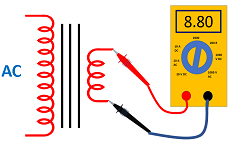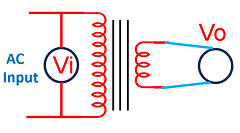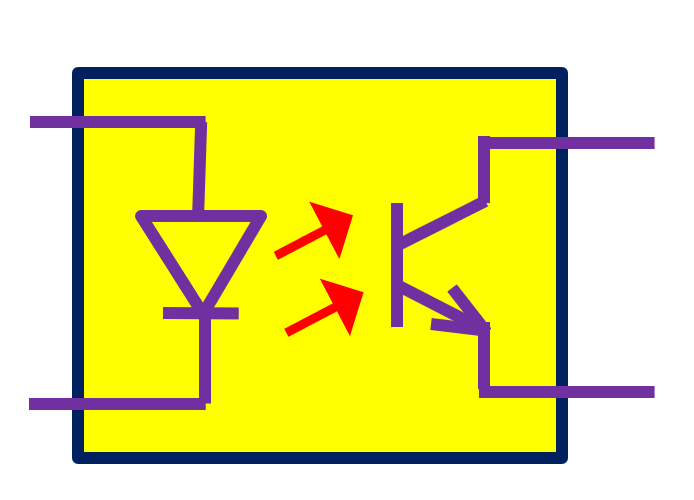We can check and do a few simple tests of the electrical transformer using a Multimeter in a very easy way at home or lab. These simple checks will be useful to find the proper functioning and working of the transformer in any electrical appliances or equipment.
Electrical transformers are used in many electrical equipment. There are many checks and tests performed by the manufacturer of the transformer for the proper function of the transformer using many methods including the multimeter.
But they are complex in nature and not practical to do at home.

We have very limited resources to check and test the transformer at home or in the lab. The methods explained in this article are simple and practical in nature. This requires just a multimeter to perform the test.
Transformer check using a multimeter
We can do the following check of the transformer using a multimeter:
- Resistance of the primary winding
- Resistance of the secondary winding
- Wire break in the primary winding
- Wire break in the secondary winding
- Insulation failure
- Any shorting between the primary and secondary winding
- Voltage ratio measurement
- Voltage drop at various load conditions
Check open circuit in windings
We can check the open circuit in the primary or secondary winding in the transformer using a multimeter.
We simply can measure the resistance of the primary winding by connecting the multimeter across the two terminals of the windings.
The resistance of the winding may be from a few ohms to a few hundred ohms depending on the transformer rating and its quality.
However, the value of the resistance is not that important. But if the winding is open, then it will show an open circuit by showing many kilo or mega ohms resistance values by the multimeter.
High or low voltage winding difference and check in transformer
The high voltage windings of the transformer will have more turns and also use thinner wire. So the resistance of the high-voltage winding will be more. Further resistance of the low voltage winding will be less due to less turn and thick wire.
So by measuring the resistance of all the windings, we can find which winding is of high voltage type and which winding is of low voltage type.
However, we can not check and find the voltage rating of the winding in the transformer using a multimeter as per this method.
Short circuit between primary and secondary in isolation transformer
We can check and measure the resistance between one terminal of the primary winding and one terminal of the secondary winding of the transformer using a multimeter. This should show an open circuit in the case of the isolation transformer.
We must keep the setting of the multimeter at a high resistance scale for this test.
However, in the case of autotransformers, there will be resistance between the primary and secondary winding in the transformer, as there is no isolation.
Insulation failure check in transformer with a multimeter
If the insulation of any winding fails and copper wire touches the core, then we can check this in a transformer. We can measure resistance between the one terminal of winding and the core of the transformer.
We can do two checks for this. One for primary winding and another for the secondary winding of the transformer.
Voltage ratio check in transformer using a multimeter
For this check and test, we apply the AC supply of suitable value as per the rating of the transformer, across the primary winding. Then we measure the voltage across the primary and secondary winding. Refer to Figure 1.

Then by dividing across secondary and primary, we can find the voltage ratio of the transformer. And it will be equal to Ratio = Vo/Vi. Vo is the voltage across the secondary winding and Vi is the voltage across the primary winding.
As voltage will fluctuate and change with time. So it is better to measure both the voltage at the same time using the two multimeters.
However please note the voltage across the secondary of the transformer depends on the load and is not fixed.
So the above method will check the voltage under no load condition. We should connect the load across the secondary to find the voltage at a certain load.
Voltage drop check in the transformer
To check the voltage drop, first, we measure the voltage across the secondary winding without any load. Then we connect a known load and measure the voltage across the secondary winding.
There will be a drop in the voltage in case of the resistive or inductor load. However secondary voltage will increase in the case of the capacitor load.
This kind of test and check of the transformer using a multimeter are simple tests only. A multimeter will not provide a comprehensive assessment of the health of the electrical transformers.
Note: dealing with electrical systems and attempting to check or repair a transformer should be done with precautions. Any electrical shock may be dangerous for the human body.
Extra knowledge as per experience
- The above checks and tests on the transformer using a multimeter are applicable only for simple observation of the transformer and are not production tests.
- The voltage at the output depends on the type and value of the load. The voltage will decrease with a resistive or inductive load but increases with a capacitor load across the secondary.
- You can observe heating in the transformer also. The low-cost inexpensive transformer for hobby purposes will heat up much more. However, still you can use it at normal home ambient temperature. It may not be suitable for high temperature ambient in the industry.
- The above test can be performed on the CT transformer, but the voltage drop test will not work.
- If only a few turns in the winding are short due to insulation failure, then we may not be able to test with this method.
Generally, a question asked, that how to find the rating of the transformer without a rating plate.
Please note that there is no test to find the rating of the transformer as per my knowledge. However, with a lot of experience, some experts may give some idea about the VA rating based on the size, wire thickness, etc.
For a detailed explanation please watch the video at:
You can also watch the details in the following video in Hindi if you like.
I hope that you enjoyed reading the article on How to check a Transformer using a multimeter at home.
If so, then subscribe to my YouTube channel.
Further, read “Open circuit CT transformer”
Continue reading ” Difference between CT and PT transformer”.
Read more on “How SMPS transformer works”.
Further, read AC or DC which is more dangerous to the human body?
About the author – G K Agrawal B.Sc and B.Tech (from HBTU Kanpur), Retd. Sr DGM Design (BHEL), the inventor of patents, has lifelong industry experience in the electrical and electronics design field of R&D. He worked for BHEL. He shares his experience and knowledge on blogs and YouTube. Read the profile here.



Very good explanation.